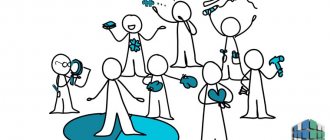Behavioral and gestural psychology of personality is a whole skill, a scientific field that explains non-verbal ways of assessing a person. In the process of communication, his image is composed mainly of external manifestations - only 30% of data about the interlocutor is acquired from direct conversation. Based on behavior and gestures, human psychology associates this phenomenon with an unconscious consideration of the interlocutor, creating a positive or negative impression of him.
Behavioral Psychology Research
A person’s appearance and habits can tell about his social status, actions, gestures - about his profession, position, character.
Behavioral psychology is based on the individual’s relationship to his environment. It includes an assessment of movement, a set of bodily responses to external stimuli, and changes. That is, behavior is a manifestation of the mental aspect of a person’s state through physiological phenomena. It is regulated by consciousness, which characterizes the individual’s worldview.
What do children tell us with their antics?
The psychology of child behavior is based on three basic principles:
- a sense of belonging to the family system;
- emotional connection with parents;
- own importance.
When the child's basic needs are satisfied (sleep, food, water), he has a desire to satisfy emotional ones. He needs to have some responsibilities assigned only to him. That is, something that depends only on him. This increases his self-esteem. He must feel that he is making a contribution to the life of the family, know that his opinion is taken into account, that he also controls events.
How to help a child and satisfy his need for significance and involvement?
First of all, it is necessary to form a close emotional connection with mom, dad and other relatives. And involve the child in discussing family problems and making decisions.
If a conflict arises with a child, talk to him; perhaps he lacks parental attention. It is necessary to let him know that he is very important and needed.
Spend time with your child at least 20 minutes a day, but it should be devoted only to him. Children love to fool around and play with their parents, this is how the strongest emotional connection is established. Do not teach him how to play with certain toys, it is better to remain non-judgmental. He must have an area of life in which he alone must make decisions. Try to become a friend, not a teacher.
How to understand a person by his behavior?
Body speech research is publicly available. There is no need for special training - today it is possible to read online books on human psychology on behavior and gestures for free.
Let us analyze the trends according to which the behavior of the interlocutor is examined.
Appearance
A person who focuses on his own appearance, looking like “from the picture,” often seeks to assert himself and hide his own indecisiveness through style. It can also mean excessive accuracy and thoroughness.
A bright, unique, sophisticated appearance indicates a creative, artistic personality. But excessive sloppiness can say not so much about artistry as about a tendency to sloppiness.
Pastel, calm colors are chosen by balanced personalities. Colorful tones are typical for emotional people.
Behavior
A person’s behavior in the environment provides the possibility of predicting his decisions and actions. Often people who keep a distance at the source of communication reduce it in the process of rapprochement. In the absence of changes in relationships, one can judge the lack of sympathy between them, and therefore the impossibility of further unity.
To work through your own fears, phobias, and self-doubt, we recommend contacting a specialist, for example, Nikita Valerievich Baturin.
How to understand a person by his behavior? Psychology points to a number of manners:
- Frequent attempts to reduce distance (staring, touching). These gestures are typical of impudent, hostile people who prefer to make their own rules.
- Physical reduction of distance, preference for conflicting, personal topics in conversation reveals importunity in a person.
- Avoidance of visual contact, manifestations of emotions, touching, indecisive behavior - people who want to hide from the outside world are prone to such manners. Clothing that hides part of the face is often typical for them.
- Relaxed, free body positions and gait indicate lack of discipline on the face and a desire to evade generally accepted behavioral standards.
- Intermittent speech and blushing are characteristics of an unstable, indecisive person. Nervous attempts to assume a comfortable position are criteria for anxiety in a particular situation.
- Dramatic positions indicate a desire to attract attention. Broad gait and gestures speak of increased self-esteem and narcissism. This behavior is typical of creative individuals, people with a masterful foundation.
- Clear, purposeful movements indicate a calculating personality and the ability to hide emotions. These properties are characteristic of thrifty people. Entrepreneurs and politicians have them.
- Erratic movements characterize an irritable personality. Useless motor skills (rotating a pen, fiddling with various objects in the hands) is a characteristic typical of nervous people.
- Calm movements indicate a lack of propensity for conflicts and plasticity of character. In combination with emotionality, this behavior indicates carelessness. Gentle gestures communicate self-control.
The psychology of human behavior also includes posture. It is important to pay attention to the following factors:
- Slouch. This is a criterion of obedience, powerlessness. Raised shoulders communicate a feeling of inferiority.
- Elevated position of the head, possibly tilted back. This position shows arrogance. At the same time as her breasts are pushed forward, she speaks of ambition and pride.
- Muscle tension, immobility. This is a criterion for the lack of ability to freely communicate with people, the desire to separate from reality. This position, according to behavioral psychology, is characteristic of a person suffering from social phobia.
- Relaxation combined with restraint. These manners are typical of a person with self-esteem.
Speech of hands
This is a primary component of communication, a generally accepted model of communication, popular mainly among the stronger sex. The greeting sign often determines the relationship between interlocutors:
- an energetic handshake - activity, sociability, pleasure from the meeting;
- handshake with palm up - readiness to communicate, trust;
- handshake with the palm down - isolation; with the elbow bent at the same time, such a greeting speaks of cruelty and duplicity;
- a handshake with the hand pointing downwards - authority, a tendency to dominate;
- weak handshake - inaction, indecision;
- clumsiness when shaking hands - shyness.
Hand position in the psychology of human behavior:
- crossing in front - a defensive reaction, unpreparedness to extend the conversation;
- behind your back - a difficult circumstance;
- fists - assertiveness, desire for self-affirmation;
- frequent touching of the face - the desire to conceal the state of mind, to hide specific facts;
- in pockets - secrecy; with sleeves rolled up at the same time - a tendency to conflicts, readiness for sudden tasks;
- friction of the bridge of the nose - reflection, assessment;
- tapping on the table, clicking with a pen - boredom, thoughtfulness.
Speech of facial expressions
Behavior is a factor in psychology that also includes a person’s facial expression, facial expressions that express mood:
- Mouth. Dropped corners are a criterion of pessimism and indignation. At the same time, pursed lips in human psychology indicate firmness of character and unwillingness to make compromises. Relaxed lips reveal passivity and weak character.
- Sight. From above - determination, malice, from below - subordination, helpfulness. Long - a requirement of obedience, running - a tendency to lie, fear.
- Laughter. This is another point of human psychology and behavior. Carefree laughter is characteristic of a natural, open personality; suppressed speaks of hostility. Giggling reveals a desire to arouse interest in one’s own person, self-praise, and hypocrisy.
Intonation
Speech, the manner of speaking, is directly associated with the transmission of information and determines the sensory state of the individual. Often a person is judged not by the content, but by the manner of conversation. The emotionality of expressions, speed, and volume of speech are taken into account:
- Restraint, prudence, and an analytical mindset are characterized by uniform speech and moderate volume.
- Rapid pronunciation of phrases, variable volume - this is a criterion of impulsiveness.
- Increased calmness is typical for a person who wants to hide emotions.
- A lack of emotionality and low volume of speech are a manifestation of a loss of interest in the conversation.
Deceptive gestures
Today, deception has become an important component of human communication. There are also a number of works in the literature that touch on the topic of lying in human psychology based on behavior. You can read them both in the classic version and online.
There are methods that allow you to identify a person who wants to deceive or misinterpret a circumstance. Behaviors typical of a liar include:
- Frequent changes in body position, coughing, touching the nose or other parts of the body, distraction aimed at gaining time to come up with the “correct” answer.
- Hiding the eyes (also typical for a person who is insecure), looking past the interlocutor, blinking frequently.
- A tense, unnatural smile, tension in the facial muscles.
Communication between a man and a woman
Perhaps most often, nonverbal means of communication are used in communication between a man and a woman. This happens unconsciously, since people who feel sympathy for each other are embarrassed to express it in words.
Some gestures and facial expressions are innate; they were used by distant ancestors to attract the opposite sex.
Ways to express male sympathy
What are a man's gestures if he likes you?
Men are secretive and shy creatures. Often they do not express their sympathy for a woman out of modesty or fear of rejection.
A woman can understand that a man likes her by the following non-verbal signs:
- Constant presence nearby. In some incomprehensible way, he finds himself in the right place at the right time to help.
- Smile when meeting. If you like a girl, then a man cannot contain his joy when he sees her.
- Observation . Men love with their eyes, so they constantly look at the object of their affection. However, seeing that his gaze is caught, the young man looks away out of embarrassment.
- Changing speech. A person in love will speak uncertainly, stammer or speak out of place.
- Nervous behavior . When communicating, a man will fidget with his tie, rearrange objects on the table, and straighten his clothes.
- Reduced voice tone.
- Violation of personal space . A man tries to be closer to a woman, to touch her. He strives to help pack things and give coats.
Reading Women's Secrets
Women are much more likely than men to use body language and facial expressions. This is due to the belief that a girl should not be the first to admit her crush.
Therefore, they often send various signs, provoking the young man to take the first step. She sends some signs unconsciously, and others quite consciously.
Signs of female sympathy:
- Glances from behind the scenes and averting the eyes.
- Tossing hair, twirling a curl around a finger.
- A slight smile and lip biting.
- Loud conversations, pronounced gestures, beautiful pose, smooth gait.
- Requests for help.
- Intentionally flirting with another man in the presence of the object of affection in order to arouse jealousy.
- Allegedly accidental touching.
However, especially shy girls will do their best to hide their attitude. You can understand that they have warm feelings for a man by certain signs:
- avoiding meetings, looking away,
- deliberate rudeness, demonstration of indifference.
At the same time, her trembling voice, redness of the face, uncertain movements, speech, and fussiness in the presence of the man she likes give away.
Books on behavioral psychology
The following works will help you find solutions to problems that have arisen and evaluate the behavior of people around you.
- R. Cialdini, “Psychology of influence. Convince. Make an impact. Defend yourself." The book contains 6 basic principles of behavior. This book about human psychology based on behavior and gestures can be read online or in the classic version.
- T. Seelig, “Make yourself. Advice for those who want to leave their mark." Emerging tasks are incentives for further movement forward. So says the author of this book.
- S. Covey, “The Seven Habits of Highly Effective People.” A guide aimed at learning to manage your own life.
- D. Myers, “Games People Play. People who play games". Another guide to behavioral psychology research.
- M. Goulston, “Mental Traps at Work.” This book about human psychology based on behavior and gestures presents information that reveals the concept of mental traps and indicates ways to eliminate them within the framework of communication.
Understanding behavioral psychology is the key to understanding your interlocutor. In addition, knowledge of this direction helps to hide one's own emotions by controlling behavior. Studying the psychology of deception helps to identify duplicity, lies, and not to succumb to manipulation.
IMPORTANT! Informational article! Before use, you should consult a specialist.
Main conclusions
Body language and gestures in the psychology of communication are a quick path to mutual understanding. It is useful for every person to learn to recognize postures, facial expressions and gestures, and the true emotions of their interlocutors. Nonverbal symbolism will allow each of us to become successful communicators.
Body language must be mastered by managers who, by the nature of their work, are required to convince subordinates and direct their thoughts in the right direction. Mastering the secrets of nonverbal communication will help you avoid difficult situations, preventing brewing conflicts.
This section of the psychology of gestures and body language is very interesting. It makes sense to develop in this direction. When mastering science, great opportunities will open up for you that you can safely apply in life!
Can you read non-verbal signs? Tell us about your experience in the comments. If the article was useful and interesting, share it with your friends on social networks. Be successful, interesting and creative! With sincere respect to you, author of the online diary, Olga











